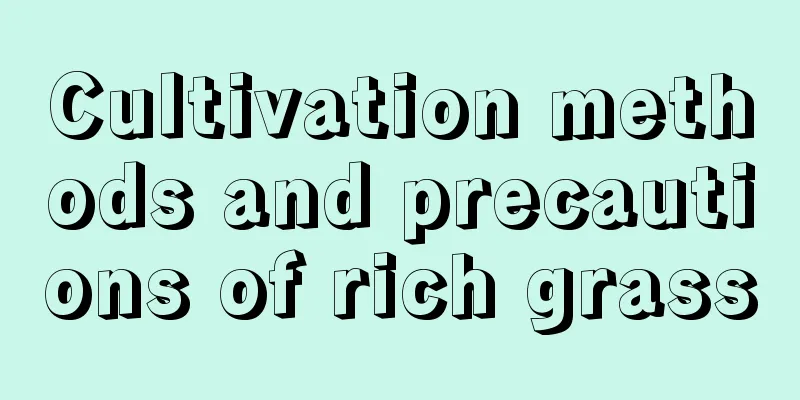Cultivation methods and precautions of rich grass

1. Maintenance methods1. Temperature: Adult Pachysandra pachysandra can withstand high temperatures. However, its germination temperature should be controlled between 20-25 degrees, so as to ensure that it can develop quickly. It is not recommended to cultivate it in the open field in winter, because frost will freeze its branches and leaves. Although it will not cause the death of the plant, it will also affect the beauty of the plant. 2. Watering: Do not water too much during the seedling stage, and control the water to prevent the plant from growing too tall. During the period of vigorous growth, the soil needs to be kept moist for a long time. Generally, water it every other day. After winter, water should also be controlled. 3. Fertilization: Top dressing is needed once during the bud formation period. Phosphorus fertilizer and calcium fertilizer can be used to promote the development of flower buds. When winter comes, fertilization should be stopped. After winter, liquid fertilizer with relatively low concentration should be used. 4. Light: It likes darkness, so it should be raised in a place where strong light cannot reach, and diffuse light should be used as the main light. If the plant is grown outdoors, it needs shade in the summer. 2. Breeding techniques1. Reproduction: It can be reproduced throughout the year. It only takes about five months from sowing to growing into a mature plant. When using the sowing method for reproduction, you need to use soil containing leaf mold, and then sprinkle the seeds into the soil, keep the soil moist, and it will germinate in about two weeks. After two months, the seedlings can be potted. 2. Pruning: When the seedlings of the plant grow to ten centimeters in height, they need to be topped. This is conducive to the branching of the plant and can also promote more flowering. After the flowers fade, the dead flowers and leaves should be cut off in time to avoid unnecessary nutrient consumption. After small new shoots grow from the old roots, you need to cut off the tiny plants that have sprouted. 3. Problem Diagnosis1. Yellowing of branches and leaves: Yellowing of branches and leaves may be caused by insufficient watering. You need to increase the amount of watering, but control the amount to avoid water accumulation in the potting soil. 2. Drooping branches and leaves: The plant is intolerant to strong light, not that it does not need light. Many people do not provide light to the plants when they grow them. This practice is wrong. The correct way is to give it three or four hours of diffuse light exposure every day. IV. Other issues1. Edibility: It cannot be eaten directly, but it can be used as medicine. 1. Other values: It has small white flowers on the top and its leaves will stick to the ground in winter, making it suitable as a forest ground cover. |
<<: Cultivation methods and precautions of winter vegetables
>>: Breeding methods and precautions of tortoise shell dragon
Recommend
Common plants in the Saxifragaceae family. What is the Saxifragaceae family also called?
1. Main features There are many species of plants...
The Flower Language and Legend of February Orchid
February orchid flower language The flower langua...
The advantages and disadvantages of the movie star rose are that it is a cut rose variety.
The Movie Star Rose is also known as the Bright P...
How to prune cucumbers? Pruning and tipping methods
Cucumber pruning time Cucumbers grow relatively f...
How to grow fishing geraniums so that they bloom full of life?
Geraniums come in a wide variety of colors, inclu...
How to prune the green treasure tree
1. Time Most of our pruning time is in the summer...
Cultivation methods and precautions of mountain thorn rose
1.Curating temperature It is relatively strong an...
What is okra?
What is okra? Okra belongs to the Malvaceae famil...
How often should I fertilize the peace tree and what kind of fertilizer is best?
How often should I fertilize the peace tree? Gene...
Can roses be planted in the yard?
Can roses be planted in the yard? Roses can be pl...
How to water the golden diamond
Watering tips for Golden Diamond Golden Diamond i...
How to grow green radish?
Pothos is a popular houseplant known for its hard...
The difference between Jianlan and Huilan
1. Different pseudobulbs The pseudobulb under the...
How to plant Liubeili in pots
Prerequisites for planting Liubeili in pots Befor...
What to do after mountain rose blooms
1. Post-flowering treatment It usually takes five...









